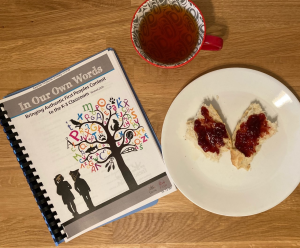15 In Our Own Words- Bringing Authentic First Peoples Content to the K-3 Classroom
Rhiannon Marshall
Contributor’s Biography:
Resource Overview
Weblink PDF:
First Nations Education Steering Committee. (2020). In our own words: Bringing authentic First Peoples content to the K-3 classroom. http://www.fnesc.ca/learningfirstpeoples/k-3/
Grade Level: Kindergarten to grade three
Description:
The resource is a guidebook that provides thematic lesson plans, integrating Indigenous Knowledges in various subject areas for participants in kindergarten to grade three. The resource provides a list of supplementary resources, frequently asked questions, and self-evaluations. Furthermore, it outlines eight different unit plans that incorporate both introspective learnings as well as Indigenous perspectives. Within the units, there are rubrics and teaching approaches that detail the lesson’s grade level suitability and the content. The resource works to support educators needing relevant and culturally appropriate Indigenous Knowledges, as it recognizes an absence of guidance on Indigenizing the curriculum.
Significant Indigenous Knowledge:
Focusing on unit five in the resource, it teaches participants about Traditional Ecological Knowledge. Traditional Ecological Knowledge, also known as TEK, “is the most popular term to denote the vast local knowledge First Peoples have about the natural world found in their traditional environment” (First Nations Education Steering Committee [FNESC], 2020, p.16). It also touches upon topics like spirituality, astronomy, medicine, and technology. Essentially, “TEK is the intellectual property of the First Nation that holds it” (FNESC, 2020, p.18). Through TEK, animals are depicted as mythological beings which have significant lessons embedded in their stories. The animals offer spiritual guidance and signify culturally relevant beings in various Indigenous communities. TEK introduces Indigenous traditions, understandings, values, and beliefs. Lastly, the resource highlights that arts, songs, and stories are all different ways of sharing Indigenous Knowledges.
Necessary Prior Knowledge:
Before using this resource, it is recommended that the educator becomes familiar with TEK. The educator must understand that TEK is complex and varies from Nation to Nation. On page 110 of the resource, the key features of TEK are described. Firstly, TEK is like a living encyclopedia. It is not one static knowledge but rather a body of different Knowledges. The core of Knowledges is grounded in interconnectedness. TEK shares connections in relations to “worldviews, values, and beliefs shared by a group of First Peoples” (FNESC, 2020, p.110). The system of knowledge varies as it is based on the ecological synergy in different regions. This type of knowledge is progressive as it accumulates over space and time. Most importantly, this TEK promotes environmental sustainability. It fosters survival skills and allows people to become adaptable and resilient in a changing environment.
Suggested Learning Activities
For the first possible activity, participants will learn how to pronounce significant places in local Indigenous languages. The instructor should familiarize themselves with correct pronunciation before teaching the lesson. The resource suggests that this may happen best by working with “a language teacher or other community members” who may be familiar (FNESC, 2020, p.111). The educator should also provide websites, like First Voices found at firstvoices.com (First Peoples Cultural Council, 2020), that pronounce words in some Indigenous languages.
Another possible activity could be to create a map with the class which indicates the region in which they are learning. The map would display significant locations and traditional territories of local Indigenous Peoples. The educator could help the participants find both the commonly known region names and the traditional Indigenous names. Participants could also outline nearby bodies of water. The emphasis would be on using traditional names and the proper pronunciation, which can be found online or with the help of the school’s Indigenous support worker.

Image by: Rachel Chong BY-NC-ND (Attribution Non-Commercial No Derivatives)
References
First Nations Education Steering Committee. (2011). Authentic First Peoples resources. http://www.fnesc.ca/authenticresources/
First Nations Education Steering Committee. (2020). In our own words: Bringing authentic First Peoples content to the K-3 classroom. http://www.fnesc.ca/learningfirstpeoples/k-3/
First Peoples Cultural Council. (2020). FirstVoices. https://www.firstvoices.com/.

